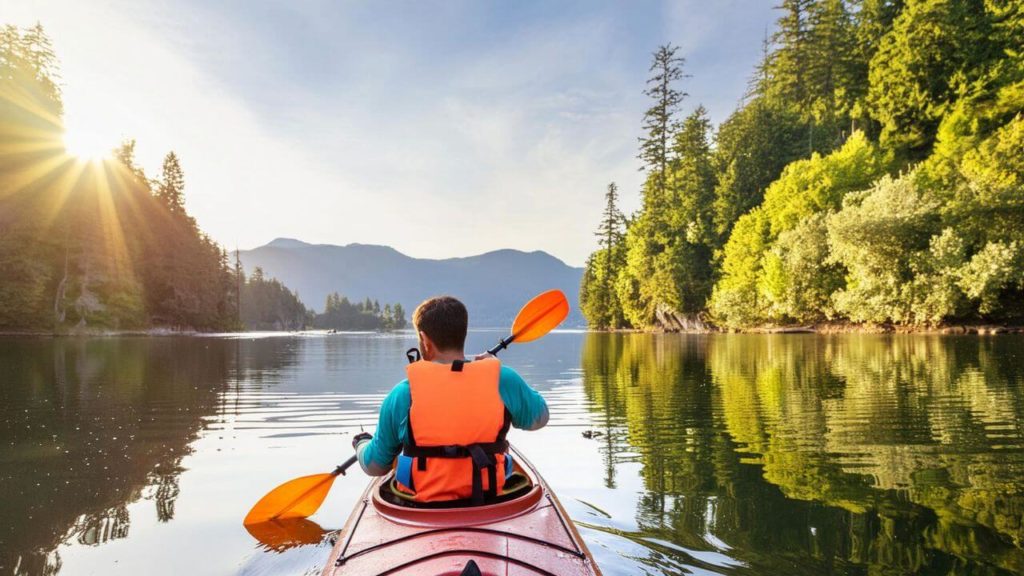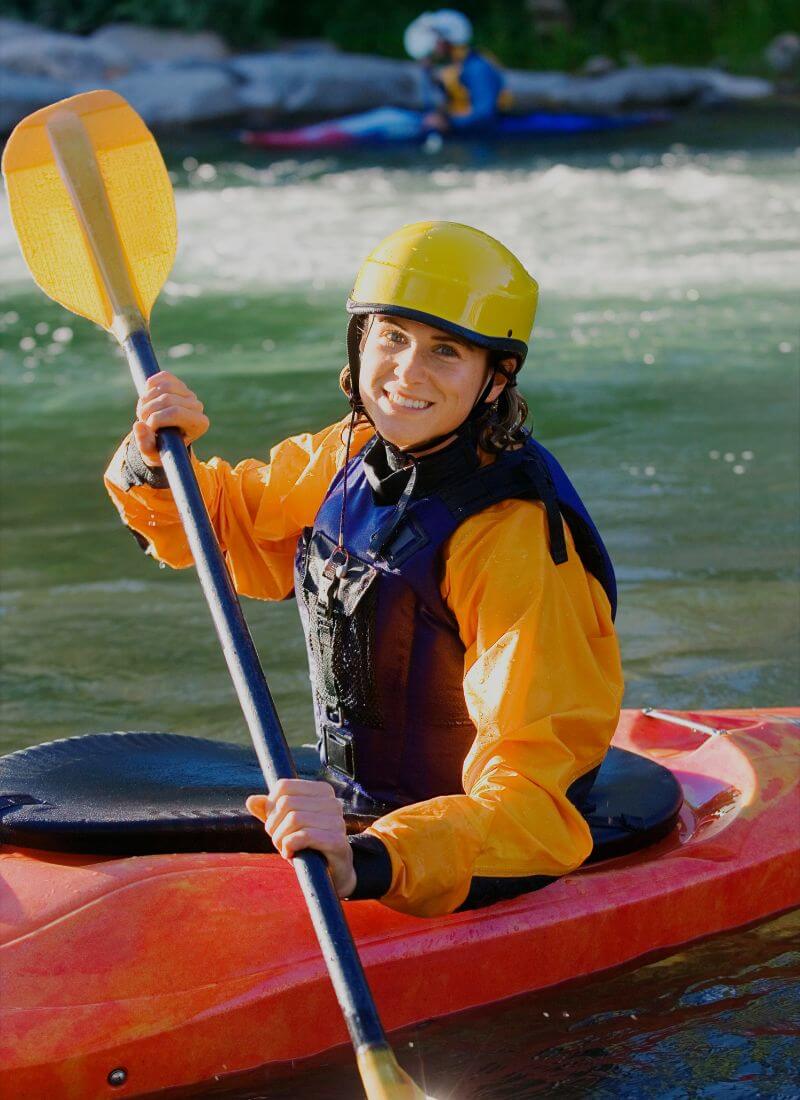Kayaking can be an exciting outdoor adventure, allowing you to explore scenic waterways and get close to nature. But for non-swimmers, the thought of tipping over into deep water can be downright terrifying. As someone who nearly drowned on their first kayaking trip, I know first-hand how scary it can be if you don’t feel confident in the water. When I was a kid, I knew the fear of drowning at that time.
That experience made me hesitant to kayak again, until my father convinced me to give it another try. With proper preparation and precautions, I found kayaking was not only safe, but incredibly fun and rewarding, even without strong swimming skills. In this article, I’ll share tips on how beginners and non-swimmers can safely enjoy kayaking without fear.
Is Kayaking Safe For Non Swimmers?
Yes, it is safe for those who can’t swim. However, safety is heavily reliant on certain factors. The primary one is wearing a personal flotation device (PFD) which ensures you stay afloat in case you capsize. PFDs are made to make sure your head stays above water, even if you’re not awake.

Another crucial factor is where you plan to kayak. For non-swimmers, calm, shallow bodies of water are recommended. They present less risk and allow for easy rescue if needed. If you’re a beginner at kayaking, it’s good to kayak with others, like a group or a guide.
Let’s proceed more & know what risks are involved while kayaking for non swimmers.
Kayaking Risks
Kayaking poses some key risks for non swimmers that are important to be aware of. The most serious risk is drowning if you capsize and are unable to reenter your kayak. Since non swimmers lack the skills to stay afloat and swim back to shore, capsizing could quickly become life-threatening.
Hypothermia is another major risk if the water is cold. Even in warm weather, water temperatures can be dangerously cold. If you end up in the water without a wetsuit, hypothermia can set in within minutes. This causes loss of muscle control, confusion, and unconsciousness.
Injury from hitting waves, rocks, or other objects is also a risk. Kayaks don’t provide much protection in the event of an impact. Non swimmers may not have the boat control skills to avoid hazards. Impact injuries like concussions are possible even while wearing a helmet.
Now you are aware of all the risks involved while kayaking as a non swimmer. Let’s learn about the safety gear that will protect you from any misadventure.
Kayaking Safety Gear
Having the proper safety gear is crucial for kayaking, especially for beginners and non-swimmers. Here are some of the most important items to have:
Life Jacket: A life jacket or personal flotation device (PFD) is absolutely essential. Make sure the life jacket fits well and is approved by the U.S. Coast Guard. Always wear it whenever you’re on the water.

Spray Skirt: A spray skirt is a nylon cover that goes around the waist and seals to the cockpit rim. This blocks water from entering the kayak from waves or splashes. A spray skirt allows kayakers to roll over and right themselves if they capsize. It’s an important safety feature, especially in cold water.

Helmet: While not always required, a helmet provides protection in case you hit submerged objects like rocks. It also shields from paddle impacts. Helmets are recommended for beginners until they gain better boat control. They are especially prudent in rocky areas or rapids. Look for lightweight whitewater helmets.

Whistle/Signal: A whistle or signaling device allows you to call for help if needed. Wear it around your neck or attach it to your life jacket.

Throw Rope: A throw rope can be tossed to someone in the water so you can pull them to safety. Every kayaker should carry one.

The Right Kayak For Non Swimmers
Choosing the right design and width kayak is a crucial point for non-swimmers as it helps safe and risk free experience. The design and width of a kayak plays a major role in its stability on the water, which is an important consideration for non-swimmers. Wider kayak models, often called sit-on-top kayaks, provide more initial stability and are less prone to tipping over. This makes them a better option for beginners.
In contrast, traditional sit-inside kayaks have a narrower width, typically around 24-28 inches wide. While these kayaks are faster and more maneuverable, they sacrifice some stability. The paddler sits inside an enclosed cockpit which raises their center of gravity and increases the chances of capsizing.
Wider sit-on-top kayak models provide non-swimmers with more confidence and security on the water. Beginners should avoid narrow sit-inside kayaks until they gain paddling experience and learn wet-exit techniques to get out of a capsized kayak.
Also Read:
Beginner Kayaking Tips
Kayaking can seem daunting for beginners, but starting slow and being prepared can make it very accessible. Here are some key tips for beginners:
Take A Class
Taking a kayaking class or lesson is highly recommended for beginners and non-swimmers. Look for classes at local paddling clubs, outdoor outfitters, or community colleges. An instructor will teach you basics like entering and exiting the kayak, paddling techniques, and how to do a wet exit to get out of a tipped kayak. Classes build confidence and allow you to learn in a safe, controlled environment.
Start on Calm, Flat Water
When first starting out, only kayak on calm, flat water like lakes, ponds, and slow-moving rivers. Avoid waves, currents, or whitewater until you’ve built experience and skills. Starting on flat water allows you to get comfortable with the kayak’s stability and practice techniques without dealing with challenging conditions. Take it easy and gradually progress to faster-moving water.
Learn Wet Exits
A wet exit (or “getting back in your boat”) is a crucial skill, allowing you to safely exit a capsized kayak. Practice capsizing and re-entering your kayak in shallow water with an instructor. Learning this can give you confidence if you tip, as you’ll know how to get out of the kayak and back in. Always wear a lifejacket, grasp the kayak, take a breath, and kick your feet out to swim away if upside down. Then surface, drain the kayak, and crawl back in.
Go For A Kayaking With A Guide Or Group
Kayaking with an experienced guide or with a group is one of the safest ways for people who can’t swim to have fun in the water. These guided trips are run by experts who teach you how to kayak safely and rescue you if something goes wrong. They pick the best routes, give you tips, and keep an eye on everyone. Some tours even let you paddle with a guide in the same kayak for extra help. Joining a club or group is another good idea because you’re safer when there are more people around. If something happens, there’s always someone nearby to help.
When To Avoid Kayaking?
Kayaking can be risky for people who can’t swim, especially in tough conditions like strong winds, big waves, storms, fast currents, or at night. Before heading out, it’s important to check the water and weather conditions. High winds and waves can push a kayak off track and even tip it over, which can be really hard for non-swimmers to deal with. It’s best for beginners to avoid kayaking in windy conditions or with big waves.

Storms can bring lightning, heavy rain, and strong winds, so it’s crucial to get off the water as soon as you see a storm coming, even if it looks far away. Fast currents, like in rapids or tidal areas, are tough to paddle against and can be dangerous, especially for non-swimmers.
Also, you should avoid kayaking at night because at night it’s hard to see, and if you capsize, it can be really dangerous, especially if you can’t swim. Beginners should stick to kayaking during the day when it’s easier to see and safer overall.
Conclusion
Kayaking can be a fun, rewarding activity for those who can’t swim if proper precautions are taken. The most important thing is to start slowly and stay within your comfort zone. As a beginner, stick to calm, shallow waterways and always wear a life jacket. Invest in a wider, more stable kayak designed for recreational paddling. Think about taking lessons or going with an experienced guide or group your first few times out. Make sure to inform someone about your planned route and designated check-in points. Avoid kayaking alone until you’ve built up skills and confidence.
Check weather and water conditions before launching. With proper preparation, gear, and mindset, non-swimmers can safely enjoy the beauty of kayaking. The key is taking a cautious, responsible approach and not overestimating your abilities. Kayaking opens up a whole new world to explore for those without strong swimming skills as long as safety remains the number one priority.

